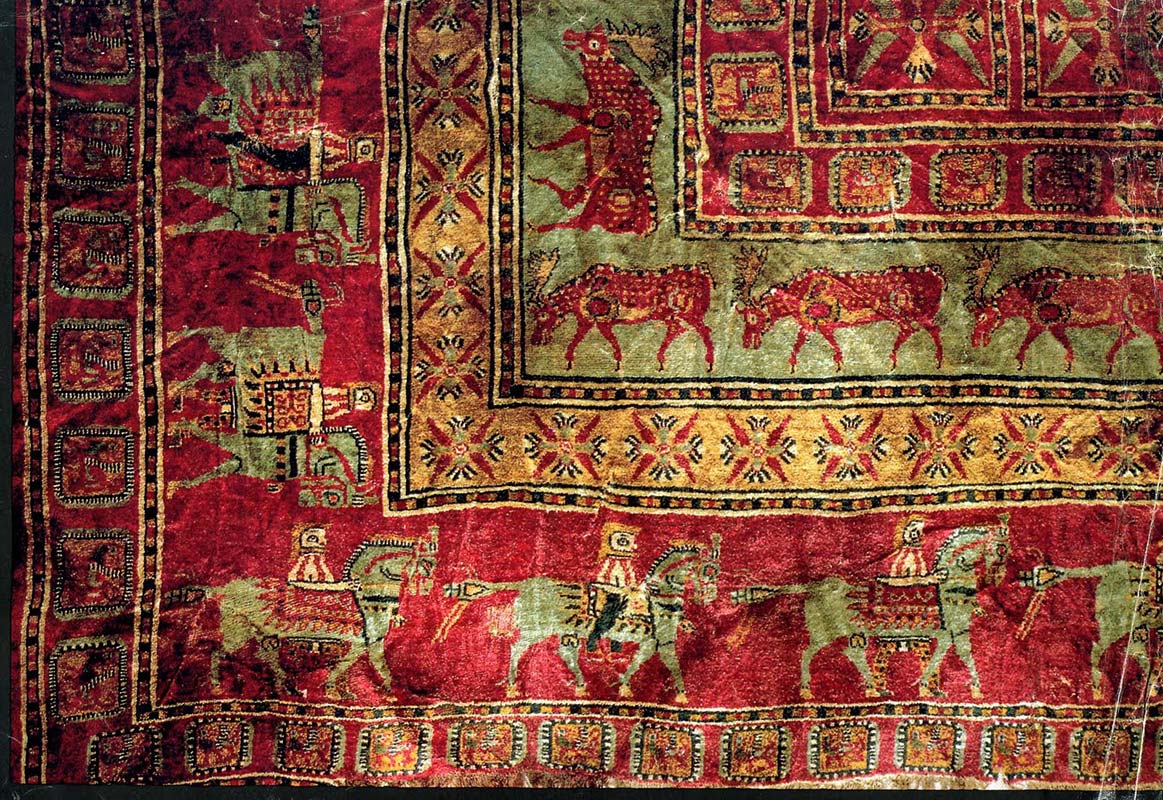
Pazyryk and the Ukok Ice Maiden : In Focus
World's Oldest Carpet: Pazyryk Carpet

Posted on 12/18/2024 12:38:28 PM PST by nickcarraway
The world’s oldest known rug, the Pazyryk, dates back to the 4th to 3rd centuries BC. Preserved by the cold, icy conditions of the Altai Mountains, it has remained in remarkable condition for over 2,500 years.
The rug’s survival is the result of unusual circumstances. In the Bolshoy Ulagan dry valley of Kazakhstan, looters ransacked the tomb of a Scythian nobleman, leaving it uncovered. This allowed cold air to freeze and protect the rug from decay. In 1949, archaeologist Sergei Rudenko uncovered the rug, which is now housed in the Hermitage Museum in St. Petersburg, Russia.
Remarkable craftsmanship and design
The Pazyryk rug’s detailed craftsmanship surprised experts. Unlike other simple floor coverings of its time, this one features intricate patterns and 3,600 symmetrical double knots per square decimeter (232 per square inch), a technique known as the “Ghiordes knot.” The rug is made entirely of wool, including both the pile and the base.
Its design includes a central ribbon pattern and a border decorated with images of deer and warriors riding on horseback. These motifs echo those found in later Turkmen and Seljuq-period rugs, as well as modern Turkish kilims.
Cultural significance and origins
The rug tells the story of the Scythians, a nomadic people renowned for their horse-riding skills, who once ruled regions stretching from Eastern Europe to Western Asia. However, its exact origins remain uncertain, sparking debate among historians.
Some scholars, such as Volkmar Gantzhorn, argue that the artifact may have been produced in ancient Armenia. They note similarities between the horse designs on the particular rug and Armenian depictions at the ruins of Persepolis in Iran.
The Pazyryk people were also highly advanced in metalworking skills, creating exquisitely detailed bronze and iron artifacts. These craft traditions were closely linked to their burial practices, which reveal a strong belief in the afterlife. The elaborate tombs, filled with valuable grave goods, were designed to ensure the comfort and protection of the deceased, reflecting a deep reverence for life beyond death.
Pazyryk and the Ukok Ice Maiden : In Focus
Besides the rug, another extraordinary discovery from the ancient Pazyryk culture is the “Ice Maiden.” This Scythian noblewoman, who lived over 2,500 years ago, was buried with rich grave goods, including a ceremonial headdress, textiles, and horses.
The textiles found with her share similarities with the famous Pazyryk rug, showcasing exceptional craftsmanship and intricate designs. Both feature geometric patterns and animal motifs, such as deer and horse riders, reflecting the Pazyryk people’s artistic and cultural traditions.
It is the Ice Maiden’s intricate tattoos, however, that truly captivate attention. Covering her arms, legs, and other areas of her body, the tattoos feature mythical creatures like griffins, deer, and wild animals. These tattoos reflect the Pazyryk’s advanced artistic skills and likely held cultural or spiritual significance, providing a fascinating glimpse into the beliefs and practices of this ancient nomadic people.
The Maiden’s remarkable preservation is due to the cold, icy conditions of the Altai Mountains, which helped freeze and protect her body after her tomb was uncovered by looters. The freezing environment allowed her body and tattoos to survive for over two millennia, offering an extraordinary glimpse into the beliefs, artistic practices, and social structure of this ancient nomadic people.
Dye analysis of the world’s oldest rug leads to controversy
Early studies suggested that the red dye in the rug is from the Armenian cochineal. However, modern research, including findings from the Bard Graduate Center in 1991, concluded the dye likely came from the Polish cochineal or other Porphyrophora species native to Central Asia and Siberia. The debate over the dye source continues among historians and researchers.
Today, the Pazyryk Rug is recognized as a remarkable artifact of ancient craftsmanship and culture. It reminds us of the importance of the preservation and care of cultural products which can be enjoyed for years if properly handled.
It appears it was warm enough in 3rd century BC Siberia to have a thriving culture.
Does it match the drapes?
Oh. So this ‘World’s Oldest Rug’ has nothing at all do to
with singer Elton John. My bad!
Absolutely gorgeous!
It tells the story Moose and Girl.
World’s first Russian colusion conspiracy.
How high can it fly?
Amazing.
Better than almost everything made in the last 100 years.
Super cool!
Mark Russell line about the work on authenticating the Shroud of Turin.
“I was with them all the way about it being genuine right up to the point I saw the International Ladies Garment Workers Union label on the bottom edge.”
Amazing!
Disclaimer: Opinions posted on Free Republic are those of the individual posters and do not necessarily represent the opinion of Free Republic or its management. All materials posted herein are protected by copyright law and the exemption for fair use of copyrighted works.